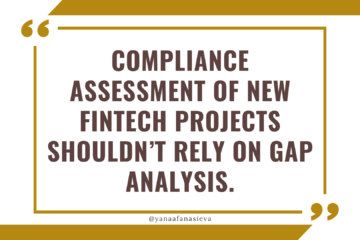Are You a FinTech CEO Who Hates to Be a Bad Cop and Always Overrule Compliance?
FinTech founders or CEOs want to be positive and inspirational and deliver only great news talking about growth, opportunities, or achievements of important milestones. They hate to resolve conflicts, take sides, admit mistakes, cancel projects, and they especially hate pushing back on compliance inefficiencies, slow processes, or poor customer experience. Especially CEOs without (long enough) prior corporate experience.
I once worked with a CEO and founder who wanted to hire a CFO with a very aggressive, risk-averse, and borderline confrontational personality because, in his own words, “I don’t want to be the most negative and most criticizing person in the company, I want to hire a bad cop”.
Another CEO told me once that the only way for him to find an agreement with his compliance team is to tell them that he accepts all the risks and all the consequences and they will never be held accountable for this decision, no matter what happens. [Which is unhealthy and unsustainable because he is training his team to be less responsible instead of them being invested and committed to the strategy chosen].
Well, if you are a CEO and who feels you need to criticize your compliance function a lot because they don’t meet your expectations or cannot find the right balance between commercial interests, customer experience, speed, and managing regulatory risks, I have good news and bad news for you.
Bad news:
- It’s not going to magically get better without you having a new strategy for how to solve this.
- Your compliance team won’t wake up one day and become more pragmatic, enlightened, or more customer-focused. If you keep doing what you are doing (or not doing), the results will be the same. Risk-averse old-fashioned compliance is like Hydra: you chop off one head or one process and it grows 3 new processes in revenge.
- There are no quick solutions. One new decision, one additional meeting or one new KPI, or one new extra bonus won’t work. Why? Because slow, expensive, and inefficient compliance is a result of a certain mindset and beliefs system, a certain perception of what’s good and what’s bad for the company. So, even if you overrule one specific case or specific decision that’s too conservative or too expensive, your compliance team will keep generating similar inefficient processes, redundant checks, or unreasonable requirements day after day after day – simply because this is how their brains are wired.
Good news:
- You can change the attitude of your compliance team over time and introduce new strategies and more modern approaches to risk-taking. Any reasonable compliance person can see the benefits of the “just in time” versus “just in case” compliance when they see that it can actually work.
- Start small and don’t try to make a huge overhaul of everything in one quarter. Use new projects or new processes as pilots. For example, when you are building a new transaction monitoring and deploy new tools, when your new head of compliance joins, when you prepare for new licenses. Don’t threaten the legacy directly.
- Always have an efficient review process and use data to support the review. For example, analyze how many customers you lost because they were tired of waiting and went elsewhere; or how many alerts ended up being false positives, and how many manual reviews did not produce any findings and resulted in dismissals and lost time. Analyze the cost of compliance per new customer and extrapolate how many people you need to hire if you have 5x or 10x the number of customers next year – will your company survive? When you offer feedback using numbers and data, it becomes more objective and less confrontational.
Does it resonate? What’s been your experience?
If you’d like to learn more about Just in Time compliance and how it works – you are welcome to subscribe to the Compliance That Makes Sense Podcast on:


